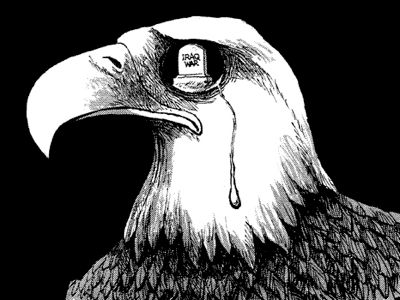In 2006, we wrote a book with Addison Wiggin called Empire of Debt: The Rise of an Epic Financial Crisis. The idea of the book was as follows:
Empires are not the result of conscious thought; they happen when a group is large enough and powerful enough to impose itself on others. But empires are expensive. They are typically financed by theft and forced tribute. The imperial power conquers… steals… and then requires that its subjects pay “taxes” so that it can protect them.
The US never got the hang of it. It conquers. But it loses money on each conquest. How does it sustain itself? With debt.
It doesn’t take tribute from the rest of the world; it borrows from it. As far as we know, no other empire has ever tried to finance itself by borrowing. But it is a special kind of debt. The US borrows in its own currency – which it can print as it chooses. If the burden of repayment is too high, in theory, the Fed can just print more dollars to satisfy its obligations.
(Photo credit: )
Here is further insight from two foreign policy professors Flynt Leverett and Hillary Mann Leverett:
“Since World War II, America’s geopolitical supremacy has rested not only on military might, but also on the dollar’s standing as the world’s leading transactional and reserve currency. Economically, dollar primacy extracts “seignorage” – the difference between the cost of printing money and its value – from other countries, and minimizes US firms’ exchange rate risk.
Its real importance, though, is strategic: Dollar primacy lets America cover its chronic current account and fiscal deficits by issuing more of its own currency – precisely how Washington has funded its hard power projection for over half a century.”
In the 1950s and 1960s, this posed little risk to foreigners, because the US dollar was backed by gold. But in 1971 – on August 15 – President Nixon repudiated the greenback’s gold backing – click to enlarge.
Global Inflation
Nevertheless, the dollar reigned supreme. Foreign nations needed to stock dollars in order to settle up on their overseas financial transactions. The US printed dollars… Americans spent them on foreign goods… foreign central banks bought them from their local merchants and manufacturers, and reinvested much of them in US government debt.
The dollars went out … in exchange for valuable goods and services … and then they came back in exchange for – more pieces of paper!
Year after year, the US ran a trade deficit. Year after year, US paper dollars and Treasury debt stacked up in foreign banks. We haven’t done a recent calculation. But the last time we looked, net cumulative deficits were approaching the $10 trillion mark.
When foreign central banks took in dollars, they had to print local currencies to give to local exporters in exchange for dollars. The owner of an export firm presented the dollars to the local bank; he needed yuan, yen or zlotys to pay his bills. The local central bank invested those dollars back in the US.
This is how the US credit boom led to an explosion of cash and credit all over the world. Foreign central banks had to increase their money supplies – by printing up local currencies – to use to exchange for the rush of dollars.
This is what led Ben Bernanke to refer to a “global savings glut.” Actually, these were not savings at all – but money created ex nihilo by central banks. Our point is that all empires end when they are defeated by a more vigorous empire… or when their financing runs out.
China's forex reserves: this is one of the symptoms of US debt and money supply inflation - click to enlarge.
The Beginning of the End
And now we are seeing the beginning of the end. From the Leveretts:
“America is increasingly viewed as a hegemon in relative decline, China is seen as the preeminent rising power. Even for Gulf Arab states long reliant on Washington as their ultimate security guarantor, this makes closer ties to Beijing an imperative strategic hedge. For Russia, deteriorating relations with the United States impel deeper cooperation with China, against what both Moscow and Beijing consider a declining, yet still dangerously flailing and over-reactive, America.”
Economist Liam Halligan, writing in British newspaper The Telegraph elaborates:
“Beijing has struck numerous agreements with Brazil and India that bypass the dollar. China and Russia have also set up ruble-yuan swaps pushing America’s currency out of the picture. But if Beijing and Moscow – the world’s largest energy importer and producer respectively – drop dollar energy pricing, America’s reserve currency status could unravel. That would undermine the US Treasury market and seriously complicate Washington’s ability to finance its vast and still fast-growing $17,500 billion of dollar-denominated debt.”
When the money runs out… so does the empire. Perhaps with a whimper. Or maybe a bang.
How hegemons decline, via JCMargeson – click to enlarge.

One of the left-overs of the Western Roman Empire. They didn't expect this to happen, but ultimately, Rome was brought down by the same overreach and the same reaction to its failure that brings down all empires. What ultimately ended the Roman empire was, you guessed it, inflation and price controls!
(Photo by DAVID ILIFF. License: CC-BY-SA 3.0)
























Laissez un commentaire Votre adresse courriel ne sera pas publiée.
Veuillez vous connecter afin de laisser un commentaire.
Aucun commentaire trouvé